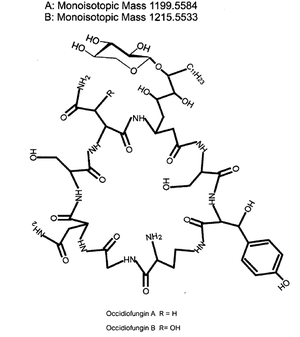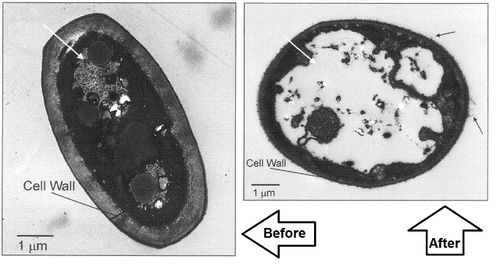Burkholderia contaminans: Difference between revisions
mNo edit summary |
No edit summary |
||
| Line 1: | Line 1: | ||
{{Uncurated}} | |||
==Classification== | ==Classification== | ||
{| | {| | ||
Revision as of 15:38, 13 August 2013
Classification
Bacteria (Domain); Proteobacteria (Phylum); Betaproteobacteria (Class); Burholderiales (Order); Burkholderiaceae (Family); Burkholderia (Genus); Burkholderia cepacia complex (Species Group); Burkholderia contaminans (Species)
Description and Significance

Burkholderia contaminans belongs to a group of closely related bacteria called the "Burkholderia cepacia complex" ("Bcc"), specifically within a subgroup of Bcc known as “Taxon K” or “Group K.” Cells of this species are non-sporulating, aerobic, and Gram-negative rods that form moist, metallic colonies when plated. These colonies are usually pigmented yellow. One significant feature of this species is that most strains are hemolytic [3]. Only 4% of all Bcc species are hemolytic, but this percentage increases to 39% in clinical culture specimens [7]. Growth of B. contaminans has been observed between temperatures 30°C and 42°C and it is therefore considered mesophilic.
Bcc species have received attention because they cause infections that are difficult to treat, as they are quite resistant to antimicrobial substances. They form biofilms and have efflux pumps in their membranes that significantly decrease the effectiveness of antibiotics. They are also resistant to antimicrobial peptides produced by host cells such as lysozyme and phospholipase [6].
Genome
Although the genome sequence for B. contaminans is currently incomplete, there is a lot of information about its species group, the Burkholderia cepacia complex, for which all currently known members share the following common features:
- i) all Bcc members have genomes that are between six and nine million base pairs, which are very large for bacterial genomes.
- ii) the 16S rDNA is greater than 98% identical between species of Bcc [12]
- iii) they have three chromosomes: c1, c2, and c3.
The genome of B. contaminans has a relatively high GC content of 67 mol% [3]. Like other Bcc members, it contains a high frequency of mobile genetic elements, and genomic islands relative to non-Bcc members, which imply that these bacteria were often involved in horizontal gene transfer events. Experiments removing c3 have shown that it is not needed for Bcc species to grow under laboratory conditions, although removing c3 inhibits antifungal production and pathogenicity of the mutant bacteria [4].
Differentiating B. contaminans from other Bcc species is a complicated task due to significant phenotypic difference between different strains of B. contaminans [6]. The combination of genomic similarity between different Bcc species and phenotypic dissimilarity within the strains of a single species means that thorough analysis is needed to identify these bacteria. The standard that has emerged is multilocus sequence typing (MLST) of seven house-keeping genes: atpD, gltB, gyrB, recA, lepA, phaC, trpB [2,5].
Ecology
B. contaminans is found is a large range of environments. The name derives from when its genetic material was isolated from the Sargasso Sea because it was thought to be a contaminant, as other Bcc species are known to grow poorly in seawater [3]. It has been isolated from rhizosphere soil where it symbiotically decreased the damage to plants caused by fungi by secreting antifungal secondary metabolites [3]. The type strain J2956 was isolated from the breast milk of sheep infected with mastitis in 2001, making it the first time a Bcc species was implicated in the non-induced infection of animals [3]. B. contaminans has also been found contaminating products such as nasal sprays and prefabricated moist washcloths, as well as human-built water reservoirs [3].
Pathology
Burkholderia contaminans, like other members of the Burkholderia cepacia complex, are considered to be opportunistic pathogens with generally low virulence, but a large range of virulence factors. Virulence factors include extracellular lipases, proteases, and siderophores which are regulated by a quorum sensing system [5]. In addition to this, Bcc infections are hard to treat, often requiring a combination of antibiotics to be effective, and they are highly transmissible between susceptible patients [6].
Hemolytic activity is thought to be required for optimal virulence in Bcc members. The hemolytic compound of B. contaminans is produced by a non-ribosomal peptide synthetase (NRPS) pathway and is either occidiofungin or occidiofungin-like compounds depending on the strain of bacteria [7,3]. The mechanism of action for the hemolytic activity of occidiofungin is not known but it is proposed that occidiofungin attaches to cholesterol in the eukaryotic cell membranes to disrupt them, as this compound does not inhibit the growth of other bacterial species. Experimental evidence suggests that occidiofungin is a cytotoxin in addition to being β-hemolytic [7].
Although members of Bcc are generally found in cystic fibrosis patients, they can be involved in infections of other immunocompromised patients or patients with medical devices. Between June and October 2008 inclusive, there was an outbreak of B. contaminans at a German university hospital where sixty-one patients tested positive for B. contaminans. The severity of symptoms caused by B. contaminans infection is often unpredictable; in this outbreak, the infection presented itself in various ways including colonisation, pneumonia, septicemia, and even a urinary tract infection. Sixteen of the infected patients died in the hospital, though none of the deaths were attributed to the B. contaminans outbreak [9].
Application to Biotechnology

The MS14 strain of B. contaminans was isolated from soil where typically pathogenic fungi were found to do minimal damage to their host plants and it was studied for its antifungal properties, which are due to a secreted compound called occidiofungin. Occidiofungin is described as a cyclic glycopeptide with two variants, occidiofungin A and occidiofungin B, which are the same in structure except that occidiofungin B has an additional oxygen atom. Occidiofungin alters the outer structural components of fungi, resulting in thinner cell walls and deformed hyphae [8]. This interference with the cell wall of fungi has an unknown mechanism but is thought to be distinct from the mechanism which causes occidiofungin to be hemolytic to eukaryotic cells.
There has been commercial interest in using occidiofungin as a medical or agricultural antifungal, as in the case or protecting crops to promote plant growth or treating patients with fungal infections. However because occidiofungin itself has toxic properties and B. contaminans is an opportunistic pathogen, the consequences of occidiofungin usage are unclear and need to be further studied [3]. It currently seems like the best approach is to create structural analogs of occidiofungin that do not have negative effects on humans instead of using occidiofungin itself.

References
[1] Matias, Fernanda and Rodrigues, Maria Filomena de Andrade. “New PHA products using unrelated carbon sources.” Braz. J. Microbiol., 2011, DOI: 10.1590/S1517-83822011000400017
[2] Jolley, Keith. (November 19, 2012) “Burkholderia cepacia complex MLST Databases” from http://pubmlst.org/bcc/info/protocol.shtml
[3] Elka Vanlaere, Adam Baldwin, Dirk Gevers, Deborah Henry, Evie De Brants, John J. LiPuma, Eshwar Mahenthiralingam, David P. Speert, Chris Dowson and Peter Vandamme. “Taxon K, a complex within the Burkholderia cepacia complex, comprises at least two novel "species, Burkholderia contaminans sp. nov. and Burkholderia lata sp. nov.” Int. J. Syst. Evol. Microbiol., 2009, DOI: 10.1099/ijs.0.001123-0
[4] K. Agnoli, S. Schwager, S. Uehlinger, A. Vergunst, D. F. Viteri, D. T. Nguyen, P. A. Sokol, A. Carlier, and L. Eberl. “Exposing the third chromosome of Burkholderia cepacia complex strains as a virulence plasmid.” Molecular Microbiology, 2011, DOI: 10.1111/j.1365-2958.2011.07937.x
[5] Leitão, Jorge H; Sousa, Sílvia A; Ferreira, Ana S; Ramos, Christian G; Silva, Inês N; Moreira, and Leonilde M. “Pathogenicity, virulence factors, and strategies to fight against Burkholderia cepacia complex pathogens and related species.” Appl. Microbiol. Biotechnol., 2010, DOI 10.1007/s00253-010-2528-0
[6] Sílvia A. Sousa, Christian G. Ramos, and Jorge H. Leitão. “Burkholderia cepacia Complex: Emerging Multihost Pathogens Equipped with a Wide Range of Virulence Factors and Determinants.” Int. J. Microbiol., 2011, DOI: 10.1155/2011/607575
[7] Thomson, Euan L.S. and Dennis, Jonathan J. “A Burkholderia cepacia complex non-ribosomal peptide-synthesized toxin is hemolytic and required for full virulence.” Virulence, 2012, DOI: 10.4161/viru.19355
[8] Shi-En Lu, Jan Novak, Frank W. Austin, Ganyu Gu, Dayna Ellis, Marion Kirk, Shawanda Wilson-Stanford, Marco Tonelli and Leif Smith. “Occidiofungin, a Unique Antifungal Glycopeptide Produced by a Strain of Burkholderia contaminans.” Biochemistry, 2009, DOI: 10.1021/bi900814c
[9] M. Martina, B. Christiansen, G. Caspari, M. Hogardt, A.J. von Thomsen, E. Ott, and F. Mattner. “Hospital-wide outbreak of Burkholderia contaminans caused by prefabricated moist washcloths.” J. Hosp. Infect., 2011, DOI: 10.1016/j.jhin.2010.10.004
[10] Lu, S., Smith, J. L., Austin, F., Gu, G. for "Occidiofungin, a unique antifungal glycopeptide produced by a strain of burkholderia contaminans." Patent No. 20110136729, (2011) from http://www.faqs.org/patents/app/20110136729
[11] Vandamme, Peter. (November 10, 2009) "Identification of Burkholderia cepacia complex bacteria." from http://www.cfww.org/pub/english/cfwnl/13/289/Identification_of_Burkholderia_cepacia_complex_bacteria.
[12] Mahenthiralingam, E., Baldwin, A. and Dowson, C.G. “Burkholderia cepacia complex bacteria: opportunistic pathogens with important natural biology.” J. Appl. Microbiol., 2008, DOI: 10.1111/j.1365-2672.2007.03706.x
